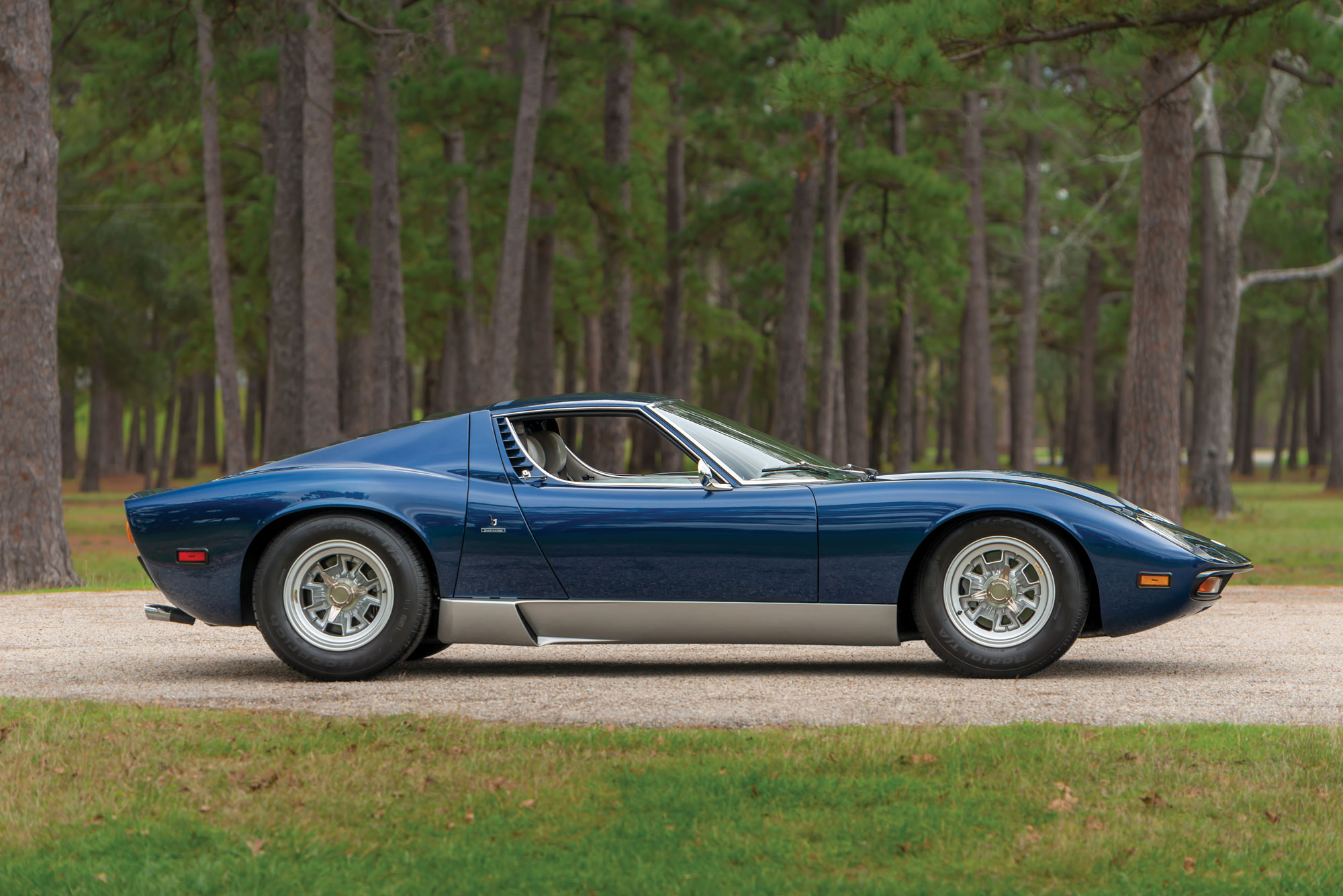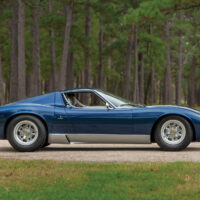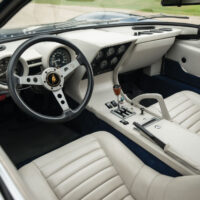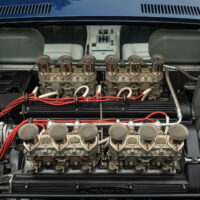The Spanish bull referred to as the Miura may have first entered the pop-culture lexicon with the publication of Ernest Hemingway’s enduring 1926 classic The Sun Also Rises. Hemingway’s disaffected expatriates travel to Spain to watch the bullfights, and there they are impressed by the brutal capabilities of the Miura, a creature that is muscular, powerful, lithe and menacing.
Forty years later, Ferruccio Lamborghini introduced his automotive interpretation of the Miura, and in every way the new model lived up to the values of its namesake. Replete with all the grace and power of Pamplona’s bulls, the Miura P400 was a revolutionary sports car in every sense, from its transversely positioned mid/rear-mounted V12 engine, to the sinewy and voluptuous coachwork designed by Bertone’s Marcello Gandini.
It is believed that this Lamborghini was originally distributed to the Rome-based dealer Carpanelli for sale to an Italian client residing in Louisiana. After passing through collections in Idaho and Florida, the Miura was eventually sold in 1990 to Bill Young of Arizona, the owner of one of the most respected suppliers of parts for vintage Italian performance cars. The P400 SV was acquired in 2001 by the well-known dealer/film producer Randy Simon, and he soon commissioned a full refurbishment by the Bobileff Motorcar Company in San Diego, one of the foremost restorers of classic Lamborghinis.
The four-year restoration reportedly addressed every mechanical and cosmetic aspect of the car, including a complete rebuild of the V12 engine by Bob Wallace, the former racing driver and Lamborghini factory test driver/engineer.
Following completion of the work, the Miura was presented at several concours, winning its class at the 2005 Concorso Italiano and at the 2007 Los Angeles Concours d’Elegance, where it was also awarded Best in Show and Most Elegant. The SV was also exhibited at the 2007 Le Belle Macchine d’Italia and won another class award at the Lamborghini Club of America’s National Meet in Monterey, CA.
Sold to the current owner in January 2011, the Lamborghini was treated to a host of measures through 2013, as indicated by invoices on file, including a rebuild of the transmission, carburetors and master cylinder. The engine and carburetors were tuned, the wiring system was repaired, a Tubi-style exhaust was installed, and the air conditioning was charged. Since then, the Miura has largely remained in climate-controlled storage, although in preparation for the current offering the car underwent a fluid service in November 2022.
Beautifully finished and powerfully specified, this rare example of the last batch of a special breed exemplifies all the remarkable traits for which the Miura is so celebrated, perpetuating the model’s mythos in a fashion that even the noted sportsman Hemingway could hardly match.
SCM Analysis
Detailing
| Vehicle: | 1971 Lamborghini Miura P400 SV |
| Years Produced: | 1971–73 |
| Number Produced: | 148 |
| SCM Valuation: | $1,611,000–$3,966,000 |
| Tune Up Cost: | $4,000 |
| Chassis Number Location: | Stamped on chassis front transversal squared pipe and on a plaque riveted behind the front left wheelarch. American cars have an extra tag riveted on upper part of dashboard, close to the windshield |
| Engine Number Location: | Within the V. Repeated on a plaque riveted behind the front left wheelarch, inclusive of model type and chassis number |
| Club Info: | Lamborghini Club of America |
| Website: | http://www.lamborghiniclubamerica.com |
| Alternatives: | 1968–73 Ferrari 365 GTB/4 Daytona, 1967–73 Maserati Ghibli, 1971–74 DeTomaso Pantera |
| Investment Grade: | A |
This car, Lot 164, sold for $3,580,000, including buyer’s premium, at RM Sotheby’s Phoenix, AZ, sale, on January 26, 2023.
The Lamborghini Miura is one of the most spectacular, sexy, provocative and extraordinary cars ever manufactured. Today, almost 60 years after its first appearance, it is still capable of kidnapping the dreams of every child.
Three series of Miura were manufactured: the early P400, the later S and the final SV. They are very different cars. The P400 was the result of hurried work, as the company needed to have the car ready as soon as was possible so it could be shown at the 1966 Geneva Motor Show. The P400 paid the price for its sped-up development. Its shortcomings were partially rectified by the S, which had a more-refined interior and improved handling when it arrived in late 1968. The final Miura series came in 1971 with the SV.
“The SV was, finally, the perfect Miura,” said engineer Paolo Stanzani, “as we finally had the right experience to create a much better car.”
Best for last
The Miura used the 3.9-liter V12 of the Lamborghini 400GT, mounted transversely behind the passenger’s compartment. Early engines made 345 horsepower and featured a single casting for the engine and its 5-speed transaxle. Output rose to 365 hp in the S, and then 385 in the SV. Later SVs gained a split sump that separated the gearbox and engine lubrication.
The SV chassis is more rigid and the brakes are bigger and more efficient. Handling was perfected, as the rear wheels and tires grew yet again, and the rear suspension and bodywork were altered to accommodate the wider track.
The addition of air conditioning helped address the Miura’s reputation as uncomfortable. They were certainly hot, loud, wild and unmannered cars from the start. Yet as soon as you get out of any Miura, your desire to climb back behind the wheel will outweigh most any concerns.
Market reversal
Every car guy who is crazy enough should get to experience a Miura in his garage. There is a reason the word “supercar” was created to describe it. But this has become a much more difficult proposition as the market for these cars has changed dramatically in the last 20 years.
For a long time, Miuras were the red-headed stepchild of the sports-car world, and many cars were forgotten or neglected. Many were in need of a serious restoration, burdened by cheaply repaired crash damage, twisted chassis, rust, electrical gremlins and so on. They are not easy cars to keep without experienced professionals to take care of them. But then the market woke up, sending values skyrocketing from under $200k to over a million in a few years. Now the situation is quite different, with most cars having been resurrected.
Our subject car, chassis 4926, previously sold for $990k at a Gooding & Company auction in 2011. This was a high price at the time, and a harbinger of valuations to come. “We early Lambo enthusiasts have been awaiting the $1m auction Miura and this one just missed it,” we wrote at the time.
Generally speaking, an SV will double the price of a lesser Miura. Over the past three years, we have seen five SVs sold at auction, making $1.4m, $4.3m, $2.9m, $2.6m and $2.3m. That high sale came at Gooding & Company’s Hubert Fabri Collection auction in 2020. It might be regarded as an outlier, as the car in question was a “Speciale,” built with a dry sump and a limited-slip differential. This places our subject car at the top of the Miura market.
Almost but not quite
It seems at first glance that everything with 4926 is perfect, and most of it is. It has the advantage of being one of the late SV cars, equipped with the split sump. It has a known history and has been restored by some of the most celebrated names in the Lamborghini and Miura world. All of this is important, but in looking closer we note that the fantastic color combination is not actually the car’s original yellow-on-black. The air conditioner also looks to be later equipment.
By all means, an owner should restore their car as they want, keeping in mind that such choices that deviate from factory original can result in being penalized on the concours field. If the lucky new owner just wants to drive this car, that’s another story. Although I doubt that such a meticulous-looking SV will see much road use. This is why, in the end, I believe the seller came out better than the buyer. ♦
(Introductory description courtesy of RM Sotheby’s.)



